Idle hours
Students demystify the everyday life, outside of work, of First Fleet convicts to discover the surprising pursuits, interests and events celebrated in the early colony by examining primary sources of information.
Key inquiry question #1
Why did Europeans settle in Australia?
Key inquiry question #2
What was the nature and consequence of contact between Aboriginal and/or Torres Strait Islander peoples and early traders, explorers and settlers?
Learning intention
Students are learning to:
- understand the routines and way of life of First Fleet convicts
- examine primary sources of information
- recognise the unique circumstances of life in early NSW
Success criteria
Students will be successful when they can:
- describe the everyday life of First Fleet convicts
- give examples of what people did during their downtime in Sydney Town
Student Activities
Being idle
Students discover convicts performed plays during their idle hours.
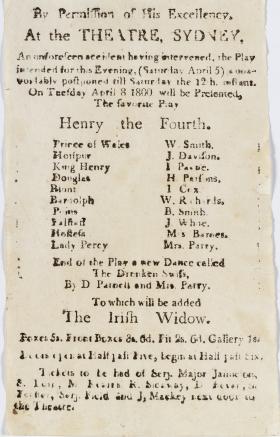
Celebrations
Students explore how special events were celebrated in the early colony.
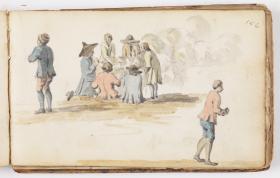
The flag’s up!
Students experience the anticipation and long wait for news and letters to arrive in the colony.
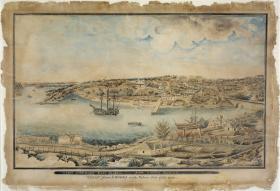
Friendships with the locals
Students investigate the early relationships between colonists and Aboriginal people and are introduced to Patyegarang.
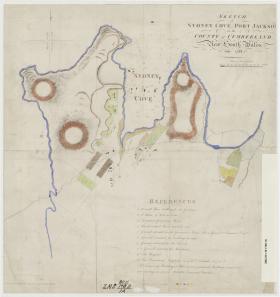
Discovering new things
Students identify the colonists’ new ‘discoveries’ and how the collecting of them impacted on Aboriginal people.
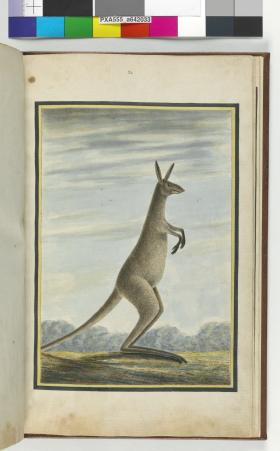
Upcycling in the colony?
Students find out about the First Fleet’s creative history of card playing in the early colony.
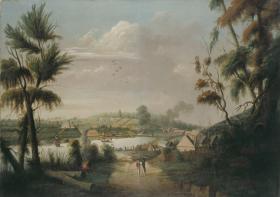
Hit the headlines
Students examine the first local newspaper printed in the colony.
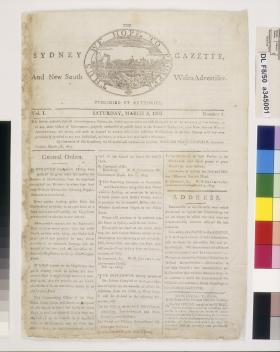
NSW Syllabus for the Australian Curriculum History K-10
A student:
- HT2-3 describes people, events and actions related to world exploration and its effects
- HT2-4 describes and explains effects of British colonisation in Australia
- HT2-5 applies skills of historical inquiry and communication
Stories of the First Fleet, including reasons for the journey, who travelled to Australia, and their experiences following arrival (ACHHK079)
Students:
- describe the establishment of the British colony at Port Jackson
- using a range of sources, investigate the everyday life of ONE of the following who sailed on the First Fleet and lived in the early colony: a soldier, convict, ex-convict, official
The nature of contact between Aboriginal people and/or Torres Strait Islanders and others, for example, the Macassans and the Europeans, and the effects of these interactions on, for example, families and the environment (ACHHK080)
Students:
- describe the nature of contact between Aboriginal people and/or Torres Strait Islander peoples and others, including Aboriginal resistance
- use sources to identify different perspectives on the arrival of the British to Australia
- outline the impact of early British colonisation on Aboriginal and Torres Strait Islander peoples' country.
Comprehension: chronology, terms and concepts:
- respond, read and write, to show understanding of historical matters
- sequence familiar people and events
- use historical terms
Analysis and use of sources:
- locate relevant information from sources provided
Perspectives and interpretations:
- identify different points of view within an historical context
Empathetic understanding:
- explain how and why people in the past may have lived and behaved differently from today
Research:
- pose a range of questions about the past
- plan an historical inquiry
Explanation and communication:
- develop texts, particularly narratives
- use a range of communication forms (oral, graphic, written) and digital technologies
Continuity and change: changes and continuities due to British colonisation of Australia.
Cause and effect: reasons for a particular historical development
Perspectives: different points of view within an historical context
Empathetic understanding: how and why people in the past may have lived and behaved differently from today.
Significance: the importance and meaning of national commemorations and celebrations, and the importance of a person or event.
Contestability: historical events or issues may be interpreted differently by historians, eg British 'invasion' or 'settlement' of Australia.
Cross-curriculum priorities:
- Aboriginal and Torres Strait Islander histories and cultures
General capabilities:
- Critical and creative thinking
- Ethical understanding
- Intercultural understanding
- Literacy
Stories of the First Fleet, including reasons for the journey, who travelled to Australia, and their experiences following arrival (ACHASSK085)
- investigating attitudes to the poor, the treatment of prisoners at that time, and the social standing of those who travelled to Australia on the First Fleet, including families, children and convict guards
- investigating daily life in the Botany Bay penal settlement and challenges experienced by the people there and how they were managed.
The nature of contact between Aboriginal and Torres Strait Islander Peoples and others, for example, the Macassans and the Europeans, and the effects of these interactions on, for example, people and environments (ACHASSK086)
- exploring the impact that British colonisation had on the lives of Aboriginal and Torres Strait Islander Peoples (dispossession; dislocation; and the loss of lives through conflict, disease, loss of food sources and medicines)
- considering whether the interactions between Europeans and Aboriginal and Torres Strait Islander Peoples had positive or negative effects
- examining paintings and accounts (by observers such as Watkin Tench and David Collins) to determine the impact of early British colonisation on Aboriginal Peoples' Country
Additional Information
The following information supports the above activities. Read the activities first.
General information about convicts and their cultural practices
The convict culture, brought with them to Sydney from their previous lives in Britain, included their language, swearing, drinking, gambling and carousing, and reflects the class differences between many of the convicts and the government officials and senior military officers. A sense of belonging would have been important to convicts as they adjusted to the brutal and dramatic changes of circumstances in their lives, and it has been suggested that maintaining their traditional cultural practices may have even been a form of resistance to the power held over them in the new colony. So, all the fun and entertainment could be viewed as not only part of their downtime or a coping mechanism but also part of this culture of defiance.
For some other ideas on what convicts were doing all day see Activity 3, What did Ann do all day?, from the Ann Martin: A Female Flogged Learning Activity.
Activity 1 Information
Theatre
This is Captain Watkin Tench’s full quote about the play in 1789:
THE anniversary of his majesty's birth-day was celebrated, as heretofore, at the government-house, with loyal festivity. In the evening, the play of the Recruiting Officer was performed by a party of convicts, and honoured by the presence of his excellency, and the officers of the garrison. That every opportunity of escape from the dreariness and dejection of our situation should be eagerly embraced, will not be wondered at. The exhilarating effect of a splendid theatre is well known: and I am not ashamed to confess, that the proper distribution of three or four yards of stained paper, and a dozen farthing candles stuck around the mud walls of a convict-hut, failed not to diffuse general complacency on the countenances of sixty persons, of various descriptions, who were assembled to applaud the representation. Some of the actors acquitted themselves with great spirit, and received the praises of the audience: a prologue and an epilogue, written by one of the performers, were also spoken on the occasion; which, although not worth inserting here, contained some tolerable allusions to the situation of the parties, and the novelty of a stage-representation in New South Wales.
This is Judge David Collins’ full quote about the first theatre in 1796:
Some of the more decent class of prisoners, male and female, having some time since obtained permission to prepare a playhouse* at Sydney, it was opened on Saturday the 16th, under the management of John Sparrow, with the play of The Revenge and the entertainment of The Hotel. They had fitted up the house with more theatrical propriety than could have been expected, and their performance was far above contempt. Their motto was modest and well chosen--'We cannot command success, but will endeavour to deserve it.' Of their dresses the greater part was made by themselves; but we understood that some veteran articles from the York theatre were among the best that made their appearance. [* The building cost upwards of one hundred pounds. The names of the principal performers were, H. Green, J. Sparrow (the manager), William Fowkes, G. H. Hughes, William Chapman, and Mrs. Davis. Of the men, Green best deserved to be called an actor.]
There is some debate about the location of Sidaway’s theatre, the first permanent theatre in Sydney. It was in The Rocks and was thought to have been either at Windmill Row (Prince Street), Bells Row (Bligh Street), or High (George) Street near Jamieson or Hunter Streets. The theatre opened in 1796 and closed in 1800.
Activity 2 Answers
Celebrations
Bumpers are large glasses full to overflowing.
Huzza is an exclamation or expression of delight.
Q: Do you think that convicts celebrated other events, like their birthdays?
A: Some convicts did not know their date of birth so they couldn’t celebrate a birthday!
Activity 3 Information
Waiting
We know that everyone was eager for ships to arrive with food in the first two years. After the threat of starvation lifted, everyone was eager for ships to arrive with letters from loved ones and news in Britain. If convicts could not read, they would listen to others reading letters and newspapers to them.
Watkin Tench’s full quote from his journal:
…we were on the tiptoe of expectation. If thunder broke at a distance, or a fowling-piece of louder than ordinary report resounded in the woods, “a gun from a ship,” was echoed on every side, and nothing but hurry and agitation prevailed. For eighteen months after we had landed in the country, a party of marines used to go weekly to Botany Bay, to see whether any vessel, ignorant of our removal to Port Jackson, might be arrived there. But a better plan was now devised, on the suggestion of captain Hunter. A party of seamen were fixed on a high bluff, called the South-head, at the entrance of the harbour, on which a flag was ordered to be hoisted, whenever a ship might appear, which should serve as a direction to her, and as a signal of approach to us… Here on the summit of the hill, every morning from daylight until the sun sunk, did we sweep the horizon, in hope of seeing a sail.
Randomly throughout the day call out “the flag’s up!” (which means that a ship had been spotted out at sea from South Head.) Students run over to a pre-determined window/s in your classroom to look for a ship or the flag with their hand-made ‘pocket-glasses’. You announce “Sorry, false alarm. Go back to what you were doing.” Repeat throughout the day. Maybe at lunchtime you or a colleague secretly places a ‘flag’ (it could be a piece of paper or even a print-out of a ship) on a fence or wall in view of the classroom window. Sometime before the end of the day and for the last time call out “the flag’s up!” – there’ll be a response!
Activity 4 Information
Patyegarang’s legacy was as an educator and her part in creating the only known first-hand written account of the Aboriginal language of Sydney. What is particularly special about this source is it is more than just a word list, it is the recording of bits of conversations between them making it the first record of phrases and whole sentences. William Dawes was being taught this language by Patyegarang at the same time she was learning English. As a result of her teaching Patyegarang is a very important person in history.
Activity 5 Answers
Kangaroo paintings
Q: Why did that happen?
A: Kangaroos were not familiar animals to the colonists. The artists may only have seen the kangaroo briefly as it was jumping across the land. It might have been painted from that memory or perhaps they painted it form a collected dead specimen or just the skin and the skeleton. The artist would have to work out what they thought the animal might look like. Later, paintings were even copied from other paintings. There was no photography to record what they could see. In part most of the people looking at natural history were not naturalists or deeply trained in observations. Artists were not natural history artists so their observations were often not very scientific. Things that naturalists wanted, like flower structure or root structure, time of the year, environment in which located etc were not recorded. Artists, or their collectors who organised them, tended to go for the colourful stuff.
Source list for image details in student activity
Image 1 & 2: Artist unknown, Watercolour drawings of sentimental genre scenes, ca. 1760-1800, ca 1760-1800
Images 1 & 2: Artist unknown, Insects watercolours, ca. 1790s, ca. 1790s
Image 1: 18th century playing cards, retrieved March 16 2022, from http://eighteenthcenturylit.pbworks.com/f/1394462078/cards.jpg
Image 1: The Sydney gazette, and New South Wales advertiser, 1803-1842